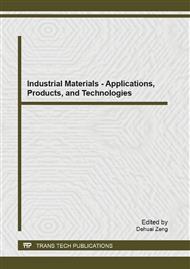[1]
Brand E, Brenner R, in: Soft Clay Engineering, Elsevier Scientific. (1981).
Google Scholar
[2]
Chen C.C., in: Special Journal on Four-year Operation of Shimen Reservoir, Administration of Shimen Reservoir (2005), in press.
Google Scholar
[3]
Chen J.C., Juang W.S., in: Geognosy, Science Series in University (1987).
Google Scholar
[4]
Cummins, A. B, and Given, I.A., in: Mining Engineering Handbook, Society of Mining Engineers, American Institute of Mining, Metallurgical and Petroleum Engineers, Inc., New York. J. H. Perry, Chemical Engineers' Handbook, McGraw Hill (1963).
DOI: 10.1002/jctb.5000500212
Google Scholar
[5]
Gao, G.C., in: Introduction to Silt Dehydrating Technology and Equipment Development, Bimonthly Journal of Taiwan Environmental Protection Industry, 26th Edition (2004).
Google Scholar
[6]
Gillot, J. E., in: Clay in Engineering Geology, Elsevier Scientific (1987).
Google Scholar
[7]
Griffiths, J.C., in: Scientific Method in Analysis of Sediments, McGraw-Hill Inc., New York (1967).
Google Scholar
[8]
Grim, R. E., in: Applied Clay Mineralogy, McGraw Hill (1962).
Google Scholar
[9]
Hsu, H.L., in: Studies on Fired Construction Materials out of Silts from Shimen Reservoir by adding Charcoal and Ashes, Master's thesis, Department of Resource Engineering, National Cheng Gung University (1998).
Google Scholar
[10]
Huang, C.H., Reservoirs in Taiwan, Walkers Cultural Ltd. Publishing. Taipei (2002).
Google Scholar
[11]
Lin, M.L., Wang, S., Rivers in Taiwan, Walkers Cultural Ltd. Publishing. Taipei (2006).
Google Scholar
[12]
Sinotech Engineering Consultants Ltd., in: Gleaning of Shihmen Reservoir Engineering, Sinotech Engineering Technology Research and Development Foundation (2005).
Google Scholar
[13]
Tsai, C.T., Wen, S.B., in: Studies of Reservoir Silts, Entrusted by the Water Resources Agency of the Ministry of Economy Affairs, Implemented by the Department of Hydraulic and Ocean Engineering of National Cheng Kung University (1998).
Google Scholar
[14]
U.S. National Science Council: Engineering Properties and Practice in Overconsolidated Clays, Transportation Research Board (1995).
Google Scholar
[15]
Wen, S.B., Huang C.Y., in: Studies on Firing Construction Materials out of the Mixture of Charcoals and Ashes with Reservoir Silts, 1998 Report on Cooperative Research Scheme of Power Science and Technology in the Industry and Academy (1999).
Google Scholar
[16]
Wen, S.B., Lei, T.T., Huang, C.Y., in: Investigation into Geographical Background and Feature of the Liquified Zone of Earthquake Soil, Collections of Papers on Seminar on Application of Land Engineering in the Assessment on Land Liquefactions (2001).
Google Scholar
[17]
Wen, S. B, Hsih, H. L, Lee, Y. C and Ye, J.Z., in: Preparation of Construction Materials from the Mixture of Coal Fly Ash and Reservoir Sludge, Proceedings of The Fifth International Symposium on East Asian Resources Recycling Technology, Tsukuba, Japan, 240-243. (1999).
Google Scholar
[18]
Wu, J.M., in: Silts and Sands Movement Studies, Association of China Civil Engineering and Water Resource Engineering. Taipei (1991).
Google Scholar
[19]
Yeh, J.C., in: Studies on Firing Construction Bricks out of Reservoir Silts by adding Charcoal and Ashes, Master's thesis, Department of Resource Engineering, National Cheng Kung University. (1999).
Google Scholar


